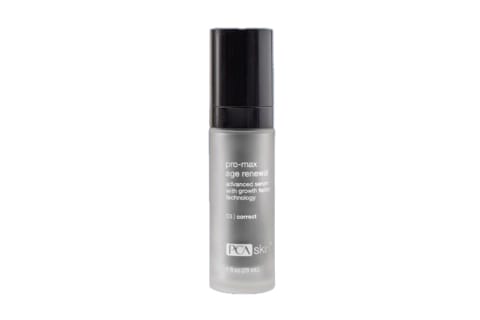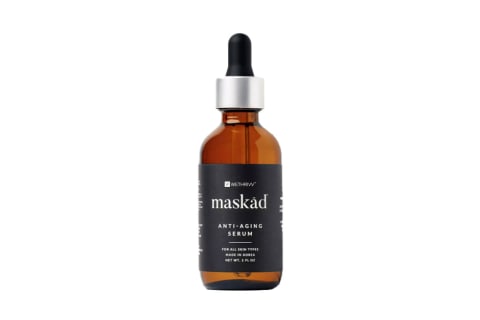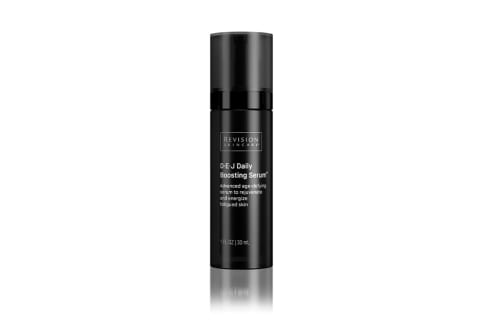Advertisement
Can A Serum Ever Be A "Face Lift In A Bottle"? Skin Rejuvenation Experts Explain


It's a face lift in a bottle! A filler alternative! Nature's Botox! You've likely heard the eager testimonials or even seen the slogans slapped on product labels themselves.
In the beauty industry, these promising claims are often met with an eye roll—they're hyperbolic at best, potentially problematic at worst. Even the most sophisticated topicals can rarely replicate the effects of a cosmetic procedure, so if one promises to manually lift the skin? Meh, likely folklore.
But the industry is constantly evolving, and right now marks an exciting time in the firming topical space. Recently, a slew of innovations has caught our attention: patented peptides, epidermal growth factor technologies, topical exosome therapies, and so on. And it turns out, their firming capabilities are not so far-fetched.
Skin sagging might be the last frontier of topical skin care…but how close are we to actually conquering it? Ahead, our investigation.
A state of the union on face-lifting topicals
The reason skin sagging is so hard to treat topically is because it's not a surface-level concern—it's a deep, structural, multifactorial issue.
Your collagen levels decline at a steady rate of 1% per year1 once you hit your mid-20s, and, sorry to say, there's not really much you can do about it; you can slow the rate of that decline with various lifestyle practices, but it will ultimately diminish—and your skin will sag as a result.
"We knew about active ingredients that could help with fibroblast activation, and therefore collagen production, but the problem always was that none of those ingredients were able to get into the deeper layers of the skin," explains board-certified dermatologist Julie Russak, M.D., FAAD. "And the surface of the skin is really not where it's happening."
That's where regenerative skin care comes in: Now, we have ingredients that can shimmy into the deep layers of your skin and help activate your own skin cells to repair.
"They increase the energy production in your cells, so the cells themselves start functioning more like younger cells that produce more collagen and elastin. Therefore, we are starting to see more and more improvement in skin sagging, crepiness, and skin laxity," Russak adds.
What are these star ingredients, you ask? Here are a few MVPs:
- Peptides: Arguably the most well-known of the bunch, peptides have certainly made a splash in the beauty industry. When used topically, they act as messengers for the skin, telling it to create more collagen. "Ingredients developed small enough to penetrate the skin yet strong enough to be effective at skin rejuvenation are exciting, and peptides have demonstrated potential as a possible ingredient to help the skin in exactly that way!" Nava Greenfield, M.D., board-certified dermatologist at Schweiger Dermatology Group in New York City, previously told mbg.
- Epidermal Growth factors: These technically fall into the "peptide" category, but they deserve their own moment as they're exceptional for collagen production. "A typical epidermal growth factor comprises 155 amino acids," says Lia Arvanitidou, Ph.D., head of research and development at PCA Skin. Meaning, it's a huge molecule that cannot typically penetrate the skin. But with new micro-growth factor capabilities, brands can make sure these molecules actually do their job.
- Exosomes: Exosomes are extracted from human stem cells, frozen to keep them stable, then applied topically on the skin after a cosmetic procedure (microneedling, lasers, and the like) to spur healing and collagen production. Usually you need some kind of "wounding" process to open up the skin's channels, but some brands have created biotech-derived exosomes with smart delivery systems that don't require a procedure—more on that later.
How & when to use them
Of course, these topicals do have their limits. It's not like someone with severe sagging will see transformative results—but when used in conjunction with cosmetic procedures, Russak notes, these topicals can totally enhance the process.
"Once we've started the process in the office, procedures that amend regenerative signals like exosomes, peptides, growth factors, and they continue using them at home, that's where we've seen really amazing results," she explains.
Not to mention, these topicals are wonderful for post-treatment care—that's how cosmetic nurse practitioner and aesthetic medicine specialist Anush Movsesian prefers to use them. "We have to drive [these ingredients] in somehow, and the best way to do that (which is what I do) is use them after skin treatments," she shares. Think lasers, microneedling, etc. "That way, you're actually driving the exosome, peptide, or growth factor into the skin."
Medical physiologist Sanjay Batra, Ph.D., co-founder of WE THRIVV, agrees: "It's a really good combination because microneedling stimulates the wound-healing response in and of itself. It produces new collagen and elastin, which is what you're losing," he tells mbg. "But then when the channels are open, if you apply growth factors, you can get the peptides and proteins into the skin to replace what you're losing."
But let's say you apply these ingredients on their own without a cosmetic treatment—will they have any effect? "I would not go and claim that topical products are suddenly going to help us with jowliness. That's probably not going to happen," says Russak. "But starting to think about it sooner rather than later and helping our cells maintain their useful energy production… That's really going to make a big difference in the future."
Essentially, it all ties back to skin longevity (which is what we've been talking about for years now!). Rather than targeting issues as they arise or committing to preventive procedures ("baby Botox" and the like), these topicals can enhance your skin's energy production for the long haul, which will inherently delay aging concerns from cropping up.
Put it this way: To kill a fly, you can use a simple flyswatter; you don't need to grab a sledgehammer. To smooth a few fine lines or an area of looser skin, you can find success with these smart topicals before resorting to a more invasive method.
What to look for
As more firming ingredients become mainstream, it's important to find formulas that actually put in the work. Here are some factors to consider:
Compatible samples
Not all peptides, growth factors, or exosomes are created equal. As a general rule, you'll want to find products that source from human tissues, not plants or animals. "In order for human [skin] to be activated by the peptide, those peptides have to have a signal capability to human cells," says Russak. "If they don't, then nothing is going to happen."
Meaning, you want a peptide, protein, or growth factor that is identical to the human peptide—humans simply don't have receptors for a plant- or animal-derived product. "It's like having a key with no lock," adds Batra.
You can slather on as many plant-derived stem cells as you please, but without the proper signaling capabilities, they won't do much more than hydrate your skin.
Efficacy
"There are a lot of companies that claim that they have exosomes in their topical products, but if you really look at the actual ingredients or do a little bit of research, you can see that the numbers are way off, or sometimes there are no exosomal products in them at all," says Russak.
In other words: Look out for "fairy dusting" in firming products. Some brands will add buzzwords like exosomes, peptides, and growth factors onto their labels for marketing purposes, but the actual amounts of those exosomes, peptides, and growth factors are actually negligible.
"It's very important to know where your products are coming from, who's producing them, and if it's a legitimate claim that they are making," she adds. If you reach out to the company, they should be willing to give you more information on their research and concentrations; if they refuse, you might want to consider that a red flag.
Ethical & sustainable sourcing
A product's sourcing methods are just as important as the quality of its ingredients. A company can use innovative human-derived growth factors with plenty of research to back them up, but where do those growth factors come from?
"One little secret that most people don't know is [some] products come from donated human foreskin tissue," says Batra. (The more you know…)
To thwart any potential ethical concerns, brands can choose to rely on biotechnology to create synthetic versions of those human-derived growth factors; so they can still signal your own cells, but they don't technically come from humans themselves. That, says Batra, is where the future is headed in terms of firming topicals.
"What's great about biotechnology is you can make it the same every time," he shares. "We use a process in our lab called biosynthesis: We know what the molecule should look like, whether it's a peptide, protein, or growth factor, and we have it made exactly the same every time."
Nicolas Travis, product developer and founder of Allies of Skin, also features a biotech-derived, humanlike molecule in his Multi Peptides & GF Advanced Lifting Serum: "The growth factors we choose to use (sh-Oligopeptide-1) is made in the lab. We deliberately chose to use sh-Oligopeptide-1 (EGF) because it has the same molecular structure and biological activity as the EGF secreted naturally by the human body," he says.
Effective delivery system
Finally, your product should have an effective delivery system. A formula can have the most ethical, research-backed peptides in the game, but if it doesn't include a high-tech method to shuttle those peptides into your skin, they likely won't get deep enough into the dermis.
"Our growth factors are encapsulated with phospholipids, which aid in the delivery of the EGF," says Travis regarding his brightening and lifting serum. "It's like a truck and trailer analogy: The phospholipids is the track pulling the EGF (trailer) into the skin. As it goes into the skin, it starts repairing the skin.""
Some brands even recommend using their products with a dermaroller or microneedling patches, which can help open up those channels and make it easier for the product to do its job. It's not absolutely necessary (and you definitely shouldn't use a dermaroller every single day), but it can help with the delivery of those actives.
Regardless, the product you choose should be clear about its delivery methods, making sure the protein stays stable and effective once you apply it to your skin.
"We did testing in human skin explants to see whether they penetrate and whether we see the impact on biomarkers that are related to collagen and elastin production," says Arvanitidou of PCA Skin's Pro-Max Age Renewal serum. "All the results came back extremely encouraging."
The takeaway
Has topical skin care completely conquered the skin sagging frontier? Well, not quite, but we're certainly on our way. "We've identified it," says Batra. "That's the first step to conquering something—it's to clearly identify what the issue is."
Your skin will ultimately sag with age, and no product (or procedure) will completely alter the natural course of life. But with these smart topicals, you might be able to slow the process within your own cells, as opposed to slapping a Band-Aid over the entire issue. It might not work as immediately, but hey, Rome wasn't built in a day.



